Media
International Eight Ball Rules
Jan 26, 2023
6j Shot Clock

Each player is allotted 45 seconds for each shot. The tip of the cue must have made contact with the cue ball within this time or a standard foul shall be granted to the opponent. The 45-second shot clock will commence once all balls come to rest. The timekeeper will verbally count down from 5 seconds.
One extension per frame is permitted per player, whereby the referee will add 15 seconds to the remaining time at the request of the player.
NOTE: The AEBF has adopted the 60 Second Shot Clock, the same as world rules. Call 30 Seconds at 30 seconds remaining, and Time Foul at 00. There is no Extension.
6g Stalemate

If the cue ball is surrounded by touching object balls on 3 sides, then the player should request a stalemate situation from the referee.
If any situation arises whereby a ‘legal shot’ (see Rule 6e (12)) cannot be played, It is a player’s responsibility to ask for a stalemate. If the referee (or opponent – if no referee) confirms a stalemate, the frame shall be restarted with a re-rack. The player who originally broke will restart the re-racked frame. If no stalemate is confirmed, the players must continue their visit.
NB: After an illegal break, if a stalemate occurs in the following re-rack, the break shall also always return to the player who originally broke to commence the original frame i.e., the illegal break.
0. International Eight Ball Pocket Template

Supreme Winner Pool Table
-
7FT Supreme WEPF Eight Ball Pool Table
-
Weight – Coin operated 230 kilos
-
2113 long x 1197 wide x 835mm high
-
Depth of cabinet – 410mm
-
Slate size – 1905 x 990mm
-
Playing area – 1829 x 914mm
-
Weight – Free play 217 kilos
NOTE: the template image is the AEBF Pocket Template, we are awaiting the WEPF Pocket Template.
5. The Rack
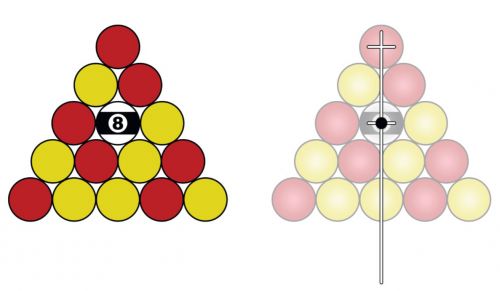
The rack should always be setup with reds at the front as illustrated by the picture in the rules. If it is not setup as per the picture, then it is wrong. Like it or loathe it, that’s where it’s at.
Why does it matter that the reds are at the front? It’s because of the rule described further down the page regarding the order in which balls are replaced behind the eight-ball spot if they need to be. The reds are the dominant colour and are always re-spotted before the yellows, and for this same reason, the dominant colour group goes at the front of the pack on setup.
Just as in the World Rules, there is NO penalty for breaking the pack if the balls are not setup correctly. It is the referee’s responsibility AND all players involved in the frame also to ensure that the balls are set correctly. If they are not, and the break goes ahead, then everyone involved with the frame has accepted the rack for what it was, and the frame simply continues as normal without any further actions.
2. Equipment Table Markings
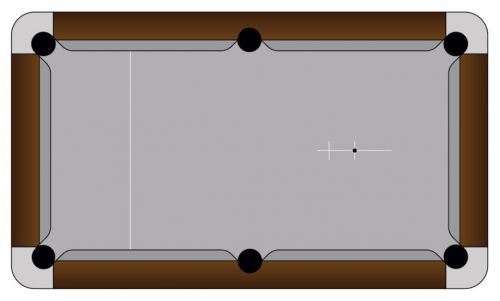
It’s called a T marker for a reason, the centre line should not go beyond the head ball spot, the 280mm line protrudes out of the bottom of the rack so that the line is directly through the centre ball of the back row.
The distance between the head ball spot and the eight-ball spot should be around 89mm.
The T marker head ball line should be around 76mm wide (1 and half balls).
This was implemented in the supreme rules.
In fact, the T marker is not in the rules anymore, never been in International Rules, just a 280mm rack line with two dots on for the head ball and eight ball.
2. Equipment Table Playing Surface
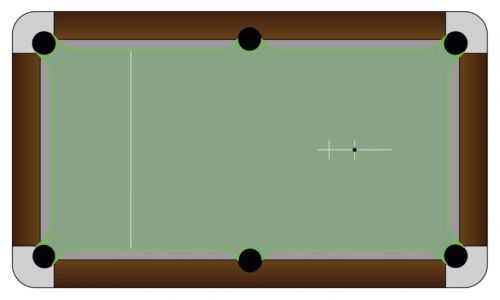
The playing surface is the flat part of the table bordered by the cushions, marked in green here.
2. Equipment Table Baulk Spot

The rules require that there is a rack line that is 280mm long with a head ball marker and a spot for the eight-ball.
They do not specify how big the spot should be or the position of the rack line in relation to the eight-ball spot which is at the intersection of the two diagonal lines between the corner pockets and the middle pockets.
It is suggested (only by the author here) that the centre of the 280mm rack line should be on the eight-ball spot, because then the rack line extends 25mm (1 inch) in front of the head ball and 25mm (1 inch) behind the centre back ball, so it can clearly be seen if the rack is ’tilted’ to one side (i.e., it is not inline with the rack line) which may give an unfair advantage to the breaker.
Additionally, by making the head ball marker line maybe 50mm – 75mm (2 – 3 inches) long so that it protrudes beyond the sides of the head ball, both players can clearly see if the rack is set high or low on the table, which can also give an unfair advantage to the breaker.
The main purpose of the rack line and its markings is to best ensure that all rack setups are equal, regardless of who is setting them up.
4. The Break
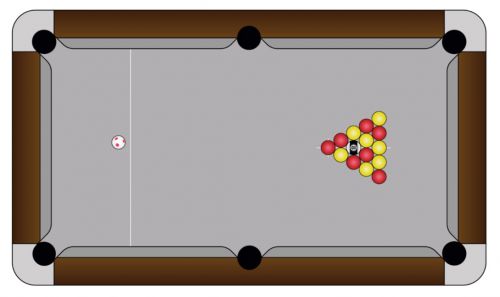
4f Three Point Break
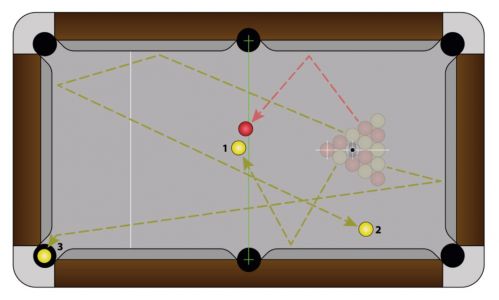
The break is only deemed legal if the breaking player scores at least 3 points from their break shot. Each ball that crosses the imaginary centre-line of the table between the centres of the two middle pockets counts for one point and also each object ball potted (including the eight-ball). Each ball can only be counted once.
Failure to perform a legal break is an automatic re-rack with the other player having the choice of who breaks.
The red ball has NOT completely crossed the centre-line of the table, so it does not count for a point.
The three yellow balls all count for one point each:
-
Yellow ball 1 counts because it has come to rest past the centre-line.
-
Yellow ball 2 counts because even though it came to rest on the rack side of the centre-line, it travelled across the centre-line and back again, so it crossed the line. Note – this might equally happen if a ball catches the low knuckle of a middle pocket.
-
Yellow ball 3 counts because it was potted, but it ONLY COUNTS ONCE. We do not give it 2 points for crossing the centre-line and being potted.
6o Touching Balls

You must play away from all touching balls at 90 degrees or more from the line joining the centres of the cue ball and the object ball(s) that it is touching.
This is different to World Rules in that if you are touching two object balls of your own colour group, you are only required to play away from one of them. This is not the case in International Rules.
Failure to do this is a standard foul and all object balls are considered, including the eight-ball.
There is no penalty for an object ball moving slightly after being played away from, just because the cue ball is no longer there.
Although unlikely, if the cue ball is touching two object balls like in the last image here, it is still possible to play away at 90 degrees, although the choice of shot direction is limited to either one way or the other, and even more unlikely that the cue ball is surrounded by touching object balls on 3 sides, then the player should request a stalemate situation from the referee.
6m Re-spotting Balls
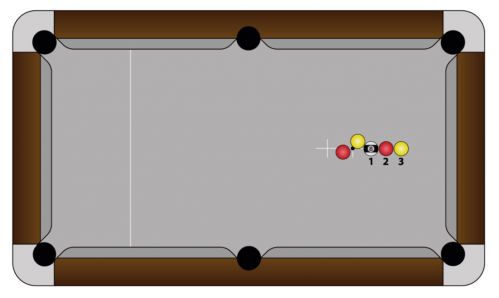
In the event that the eight-ball is potted off the break, an/or object balls come off the table, they must be re-spotted on the eight-ball mark, or as close to it in a direct line along the lengthwise centre-line of the table towards the top cushion.
The balls are placed in the following priority order where applicable and must not be touching any other balls, but be as close as possible:
-
Eight ball
-
Red ball(s)
-
Yellow balls(s)
In the event that there is not enough space to re-spot all of the balls between the eight-ball spot and the top cushion, the same process can then be applied in the opposite direction at the front of the rack, starting from the eight-ball spot and placing balls towards the baulk cushion, starting with the eight-ball, then reds and then yellows.
4e Break Behind The Line

When playing from baulk, both for the break shot and as the incoming player if the cue ball has been potted off the break, the cue ball must be placed with it’s centre point either on or behind the line.
Failure to satisfy this rule is a standard foul, even from the break shot if the break is otherwise legal in respect of points scored as described above.
-
Cue ball is Ok, more than half of it is behind the line.
-
Cue ball is Ok, it is exactly on the line.
-
Cue ball is NOT Ok, more than half of it is in front of the line.
6a Deciding Groups

When the table is open (for example, always after the break regardless of which colours were potted), the player does not have to nominate their colour group EXCEPT if the choice is not clear, like in a situation illustrated here.
The rules require that to decide groups, the player must pot the colour that they play, which then in turn means that it must be clear to the referee which colour group they are playing.
-
If the player nominates yellows, plays the yellow and pots the yellow, then colours are decided, they are yellows and they continue with their visit. Similarly if they do the same with reds.
-
If the player nominates yellows, plays the yellow and pots the red (without also potting a yellow), then this is a ‘loss of turn’ shot and the table remains ‘open’.
-
If the player nominates yellows, plays the yellow and pots the red and a yellow, then colours are decided as yellows because combination shots are allowed.
-
If the player nominates yellows, and hits the red without potting it, then control of the table passes over to the opponent, because the table was ‘open’ anyway and no foul has been committed.
-
If the player nominates yellows, and hits the red and pots it, then this is a standard foul because they are required to pot the colour that they play.
The decision about whether or not the choice was obvious is at the discretion of the referee, so for the avoidance of doubt, making a habit of nominating is not a bad thing. But, unlike the World Rules, if a colour group was potted from the break and that colour group is then nominated, the player is NOT that colour until they legally pot a ball of that group. Nomination does not decide colours, it only makes it clear to the referee what the target colour group is for the next shot.
2. Equipment Table Cushions
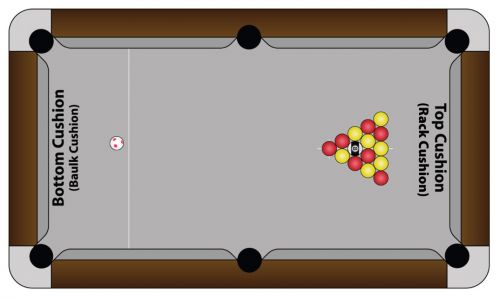
There has often been some confusion regarding which end of the table is the ‘top’ and which end is the ‘bottom’.
The concept of top and bottom comes from Billiards where the majority of points scored by skilled players happens around the ‘black spot’ of the table (so, therefore known as the ‘top’ of the table) and has cascaded down into almost all cue sports.
Sometimes in sports commentary on the TV, the ends may be swapped over, because that’s how they appear on the television from the usual camera angle facing up the screen towards baulk.
The correct end for the ‘top’ cushion is the end nearest the eight-ball spot, because we break ‘up’ the table, and the bottom cushion may also be referred to as the baulk cushion.














